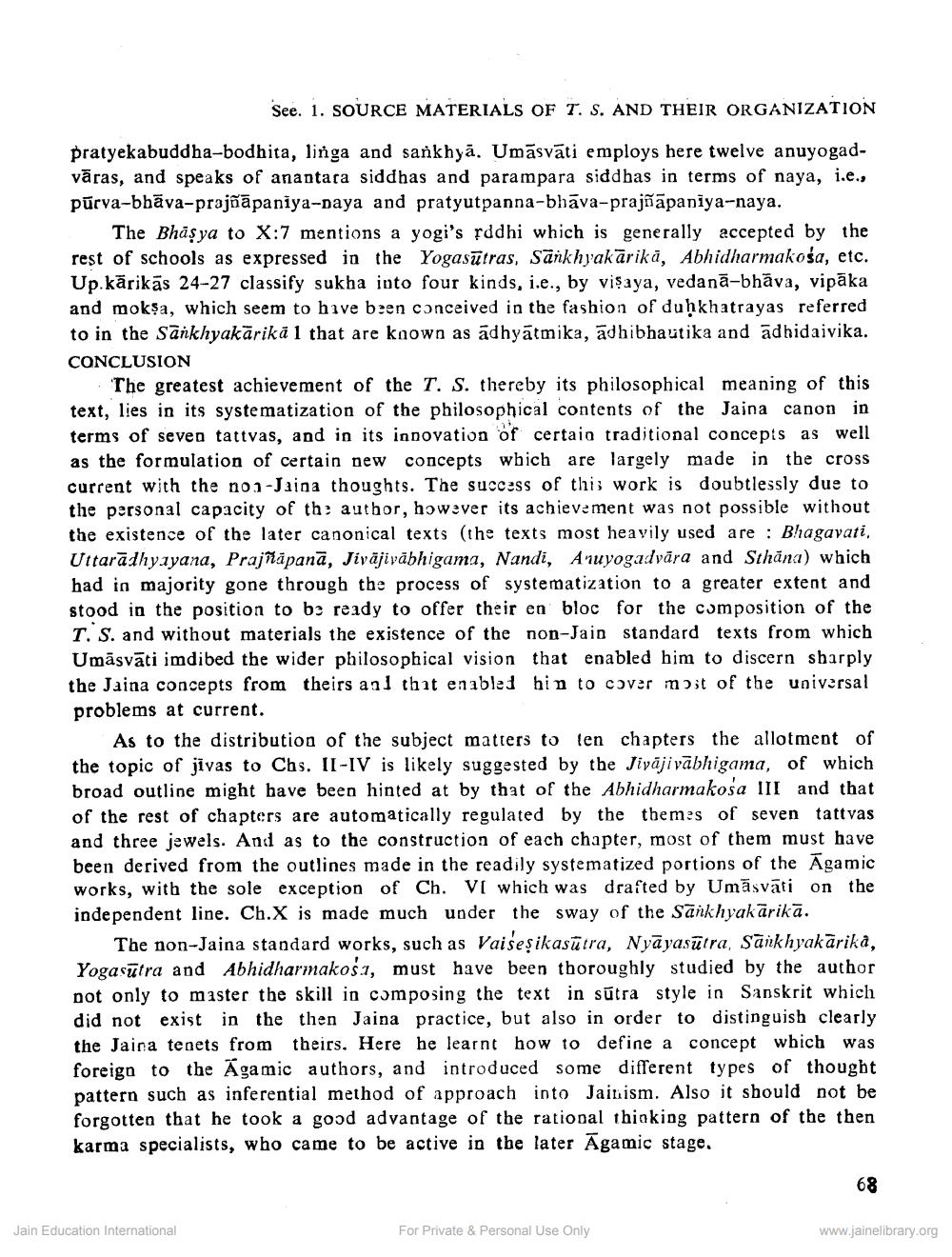________________
See. 1. SOURCE MATERIALS OF T. S. AND THEIR ORGANIZATION pratyekabuddha-bodhita, linga and sankhyā. Umāsvāti employs here twelve anuyogadvāras, and speaks of anantaca siddhas and parampara siddhas in terms of naya, i.e., pūrva-bhāva-prajñāpaniya-Daya and pratyutpanna-bhāva-prajñāpaniya-naya.
The Bhāşya to X:7 mentions a yogi's șddhi which is generally accepted by the rest of schools as expressed in the Yogasūtras, Sankhyakārikā, Abhidharmakosa, etc. Up.kārikās 24-27 classify sukha into four kinds, i.e., by visaya, vedanā-bhāva, vipāka and moksa, which seem to have been conceived in the fashion of duḥkhatrayas referred to in the Sankhyakārikā 1 that are known as adhyatmika, ādhibhautika and adhidaivika. CONCLUSION
The greatest achievement of the T. S. thereby its philosophical meaning of this text, lies in its systematization of the philosophical contents of the Jajna canon in terms of seven tattvas, and in its innovation of certain traditional concepts as well as the formulation of certain new concepts which are largely made in the cross current with the non-Jaina thoughts. The success of this work is doubtlessly due to the personal capacity of th: author, however its achievement was not possible without the existence of the later canonical texts (the texts most heavily used are : Bhagavati, Uttarādhyayana, Prajñāpanā, Jiväjivābhigama, Nandi, Anuyogadvāra and Sthana) which had in majority gone through the process of systematization to a greater extent and stood in the position to be ready to offer their en bloc for the composition of the
T. S. and without materials the existence of the non-Jain standard texts from which Umāsvāti imdibed the wider philosophical vision that enabled him to discern sharply the Jaina concepts from theirs and that enabled hin to cover most of the universal problems at current.
As to the distribution of the subject matters to len chapters the allotment of the topic of jīvas to Chs. II-IV is likely suggested by the Jiyāji vābhigama, of which broad outline might have been hinted at by that of the Abhidharmakosa III and that of the rest of chapters are automatically regulated by the themes of seven tattvas and three jewels. And as to the construction of each chapter, most of them must have been derived from the outlines made in the readily systematized portions of the Āgamic works, with the sole exception of Ch. V which was drafted by Umāsvāti on the independent line. Ch.X is made much under the sway of the Sankhyakārikā.
The non-Jaina standard works, such as Vaiseşikasūtra, Nyāyasūtra, Sankhyakārika, Yogasūtra and Abhidharmakośı, must have been thoroughly studied by the author not only to master the skill in composing the text in sútra style in Sanskrit which did not exist in the then Jaina practice, but also in order to distinguish clearly the Jaina tenets from theirs. Here he learnt how to define a concept which was foreign to the Agamic authors, and introduced some different types of thought pattern such as inferential method of approach into Jainism. Also it should not be forgotten that he took a good advantage of the rational thinking pattern of the then karma specialists, who came to be active in the later Āgamic stage.
68
Jain Education International
For Private & Personal Use Only
www.jainelibrary.org




